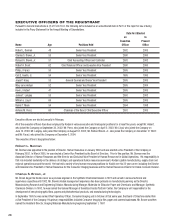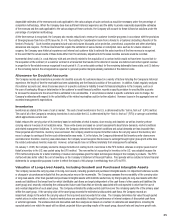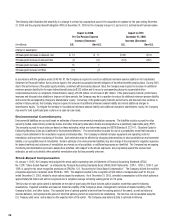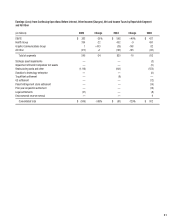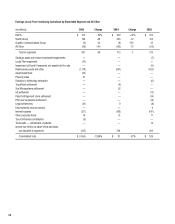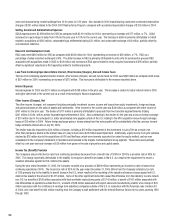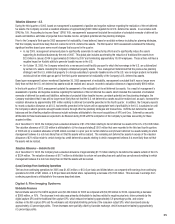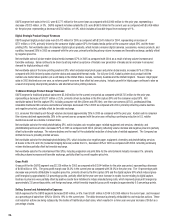Kodak 2005 Annual Report Download - page 28
Download and view the complete annual report
Please find page 28 of the 2005 Kodak annual report below. You can navigate through the pages in the report by either clicking on the pages listed below, or by using the keyword search tool below to find specific information within the annual report.26
To assess goodwill for impairment, the Company performs an assessment of the carrying value of its reporting units on an annual basis or when
events and changes in circumstances occur that would more likely than not reduce the fair value of the Company’s reporting units below their carrying
value. If the carrying value of a reporting unit exceeds its fair value, the Company would record an impairment charge to earnings to the extent the
carrying amount of the reporting unit goodwill exceeds its implied fair value. The Company estimates the fair value of its reporting units through
internal analyses and external valuations, which utilize income and market valuation approaches through the application of capitalized earnings,
discounted cash fl ow and market comparable methods. These valuation techniques are based on a number of estimates and assumptions, including
the projected future operating results of the reporting unit, discount rate, long-term growth rate and appropriate market comparables.
The Company’s assessments of impairment of long-lived assets, including goodwill and purchased intangible assets, and its periodic review of the
remaining useful lives of its long-lived assets are an integral part of the Company’s ongoing strategic review of the business and operations, and are
also performed in conjunction with the Company’s ongoing restructuring actions. Therefore, changes in the Company’s strategy, the Company’s
ongoing digital transformation and other changes in the operations of the Company could impact the projected future operating results that are
inherent in the Company’s estimates of fair value, resulting in impairments in the future. Additionally, other changes in the estimates and assumptions,
including the discount rate and expected long-term growth rate, which drive the valuation techniques employed to estimate the fair value of long-lived
assets and goodwill could change and, therefore, impact the assessments of impairment in the future.
In performing the annual assessment of goodwill for impairment, the Company determined that no material reporting units’ carrying values exceeded
their respective fair values. See “Goodwill” under Note 1, “Signifi cant Accounting Policies.” Due to the realignment of the Kodak operating model and
change in reporting structure, as described in Note 23, “Segment Information,” effective January 1, 2006, the Company reassessed its goodwill for
impairment during the fi rst quarter of 2006, and determined that no reporting units’ carrying values exceeded their respective estimated fair values
based on the realigned reporting structure and, therefore, there is no impairment.
Income Taxes
The Company records a valuation allowance to reduce its net deferred tax assets to the amount that is more likely than not to be realized. The
valuation allowance as of December 31, 2005 of $1,406 million is attributable to $177 million of net foreign deferred tax assets, including certain net
operating loss and capital loss carryforwards and $1,229 million of U.S. net deferred tax assets, including current year losses and credits, which the
Company is unable to realize. The Company has considered future market growth, forecasted earnings, future taxable income, the mix of earnings in
the jurisdictions in which the Company operates and prudent and feasible tax planning strategies in determining the need for these valuation
allowances. If Kodak were to determine that it would not be able to realize a portion of its net deferred tax asset in the future, for which there is
currently no valuation allowance, an adjustment to the net deferred tax assets would be charged to earnings in the period such determination was
made. Conversely, if the Company were to make a determination that it is more likely than not that the deferred tax assets, for which there is currently
a valuation allowance, would be realized, the related valuation allowance would be reduced and a benefi t to earnings would be recorded.
The Company’s effective tax rate considers the impact of undistributed earnings of subsidiary companies outside of the U.S. Deferred taxes have not
been provided for the potential remittance of such undistributed earnings, as it is the Company’s policy to permanently reinvest its retained earnings.
However, from time to time and to the extent that the Company can repatriate overseas earnings on essentially a tax-free basis, the Company’s foreign
subsidiaries will pay dividends to the U.S. Material changes in the Company’s working capital and long-term investment requirements could impact
the decisions made by management with respect to the level and source of future remittances and, as a result, the Company’s effective tax rate. See
Note 15, “Income Taxes.”
The Company operates within multiple taxing jurisdictions worldwide and is subject to audit in these jurisdictions. These audits can involve complex
issues, which may require an extended period of time for resolution. Although management believes that adequate provision has been made for such
issues, there is the possibility that the ultimate resolution of such issues could have an adverse effect on the earnings of the Company. Conversely, if
these issues are resolved favorably in the future, the related provisions would be reduced, thus having a positive impact on earnings.
Warranty Obligations
Management estimates expected product failure rates, material usage and service costs in the development of its warranty obligations. At the time
revenue is recognized, the Company provides for the estimated costs of its warranties as a charge to cost of goods sold. Estimates are based on
historical warranty experience and related costs to repair. Actual results have not differed materially from management’s estimates. In the event that
the actual results of these items differ from the estimates, an adjustment to the warranty obligation would be recorded.
Pension and Other Postretirement Benefi ts
The Company accounts for its defi ned benefi t pension plans in accordance with Statement of Financial Accounting Standards (SFAS) No. 87,
“Employers’ Accounting for Pensions,” and its other postretirement benefi ts in accordance with SFAS No. 106, “Employers’ Accounting for
Postretirement Benefi ts Other than Pensions.” These standards require that the amounts recognized in the fi nancial statements be determined on an
actuarial basis. See Note 17, “Retirement Plans,” and Note 18, “Other Postretirement Benefi ts,” for disclosure of (i) the nature of the Company’s plans,






